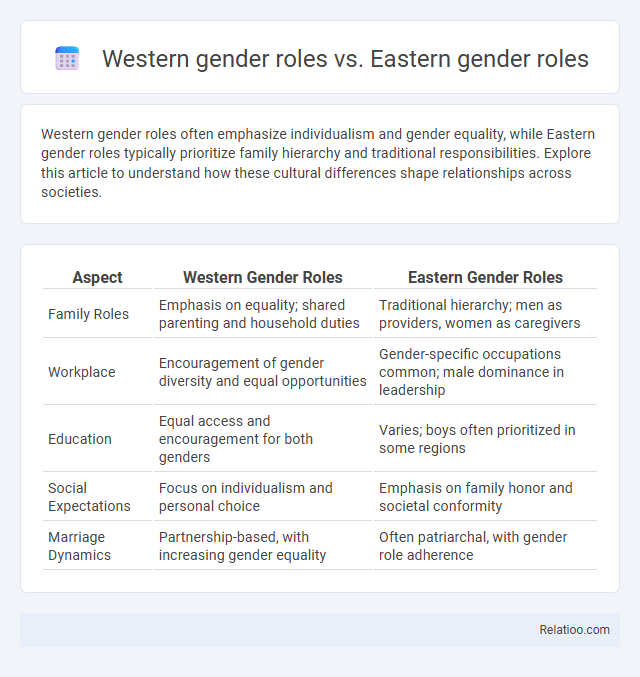Western gender roles often emphasize individualism and gender equality, while Eastern gender roles typically prioritize family hierarchy and traditional responsibilities. Explore this article to understand how these cultural differences shape relationships across societies.
Table of Comparison
| Aspect | Western Gender Roles | Eastern Gender Roles |
|---|---|---|
| Family Roles | Emphasis on equality; shared parenting and household duties | Traditional hierarchy; men as providers, women as caregivers |
| Workplace | Encouragement of gender diversity and equal opportunities | Gender-specific occupations common; male dominance in leadership |
| Education | Equal access and encouragement for both genders | Varies; boys often prioritized in some regions |
| Social Expectations | Focus on individualism and personal choice | Emphasis on family honor and societal conformity |
| Marriage Dynamics | Partnership-based, with increasing gender equality | Often patriarchal, with gender role adherence |
Historical Foundations of Western and Eastern Gender Roles
Historical foundations of Western gender roles are deeply rooted in ancient Greco-Roman traditions and Judeo-Christian values, emphasizing patriarchal authority and clear divisions between male and female responsibilities. Eastern gender roles, shaped by Confucianism, Hinduism, and Buddhism, often highlight family hierarchy and collective harmony, assigning distinct social duties to men and women within extended family structures. Your understanding of these gender role expectations benefits from recognizing how historical contexts have ingrained differing societal norms and behaviors across cultures.
Cultural Influences Shaping Gender Expectations
Western gender roles often emphasize individualism and gender equality, influenced by feminist movements and progressive legislation promoting diverse expressions of identity. Eastern gender roles tend to reflect collectivist cultural values, where traditional family structures and hierarchical roles shape expectations for men and women to fulfill specific societal duties. Cultural influences such as religion, history, and social norms significantly shape gender role expectations, reinforcing behaviors and responsibilities that differ across Western and Eastern societies.
Family Dynamics and Gender Responsibilities
Western gender roles often emphasize individualism, with a growing acceptance of shared family responsibilities and more fluid expectations for both men and women in caregiving and household duties. Eastern gender roles traditionally prioritize patriarchal family dynamics, where men are typically seen as breadwinners and women as primary caregivers, rooted deeply in cultural and societal norms. Gender role expectations across both regions influence family dynamics by shaping division of labor, decision-making authority, and emotional support systems within households.
Gender Roles in Education and Career Paths
Western gender roles in education and career paths emphasize individual choice and gender equality, encouraging women to pursue STEM fields and men to engage in caregiving professions. Eastern societies often maintain traditional expectations, with women more likely to be directed toward humanities and social sciences, while men dominate engineering and technical fields. Gender role expectation shapes educational attainment and professional opportunities, reinforcing societal norms that influence career trajectories and wage gaps globally.
Marriage, Relationships, and Gender Norms
Western gender roles often emphasize individualism and equality in marriage and relationships, promoting shared responsibilities and emotional expression between partners. Eastern gender roles traditionally prioritize family hierarchy and distinct duties, with expectations of male authority and female caregiving shaping relationship dynamics. Gender role expectations across cultures influence behaviors and social norms, impacting marital roles, communication patterns, and societal acceptance of non-traditional partnerships.
Religion and Its Impact on Gender Roles
Religion profoundly influences Western and Eastern gender roles, shaping societal expectations and behaviors. In many Western cultures, Judeo-Christian values have historically emphasized distinct male and female roles but are increasingly embracing gender equality due to secularization and feminist movements. Conversely, Eastern traditions, often rooted in Hinduism, Buddhism, and Confucianism, maintain more rigid gender role expectations, with religious doctrines prescribing specific family and social duties that influence Your identity and responsibilities.
Media Representation of Masculinity and Femininity
Western media often portrays masculinity through traits like independence and assertiveness, while femininity is depicted with emphasis on beauty and nurturing, reinforcing traditional gender role expectations. Eastern media representation blends cultural values with evolving norms, frequently balancing respect for tradition with modern expressions of masculinity and femininity. Your understanding of these portrayals can illuminate how media shapes and reinforces societal expectations across cultures.
Modern Shifts and Evolving Attitudes
Modern shifts in gender roles reveal a growing convergence between Western and Eastern societies, where traditional expectations are increasingly challenged by movements advocating for gender equality and individual expression. In Western cultures, evolving attitudes emphasize fluidity and dismantling rigid binaries, while many Eastern contexts witness gradual but significant reinterpretations of gender roles influenced by globalization and urbanization. The ongoing transformation of gender role expectations reflects a complex interplay of cultural heritage, economic factors, and generational values reshaping identities across diverse social landscapes.
Legal Rights and Gender Equality Movements
Western gender roles have seen significant shifts due to robust gender equality movements and comprehensive legal rights such as equal pay acts and anti-discrimination laws. Eastern gender roles often retain traditional frameworks, although recent legal reforms in countries like Japan and India have aimed to improve workplace equality and combat gender-based violence. Gender role expectations globally are challenged by ongoing advocacy for legal reforms that promote equal rights, reflecting both cultural resistance and progress in achieving gender parity.
Cross-Cultural Comparisons and Globalization Effects
Western gender roles often emphasize individualism and gender equality, encouraging fluidity and challenging traditional norms, while Eastern gender roles are typically rooted in collectivism, family hierarchy, and clear distinctions between male and female responsibilities. Cross-cultural comparisons reveal that globalization facilitates the exchange of gender role expectations, blending Western progressive ideals with Eastern traditional values, influencing societal norms worldwide. Your understanding of these dynamics is crucial in navigating the evolving landscape shaped by media, economic integration, and transnational policies promoting gender equity.

Infographic: Western gender roles vs Eastern gender roles
 relatioo.com
relatioo.com